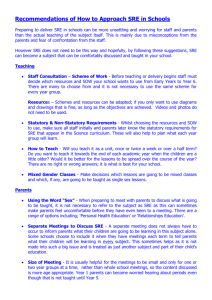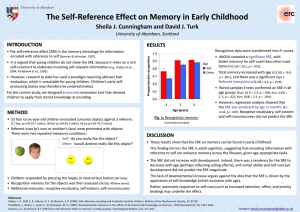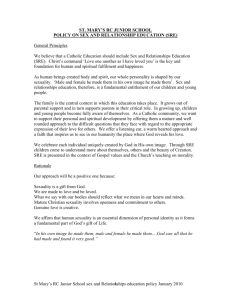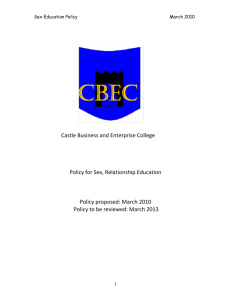Draft User Manual OOram/SRE Static Reverse Engineering Trygve
advertisement
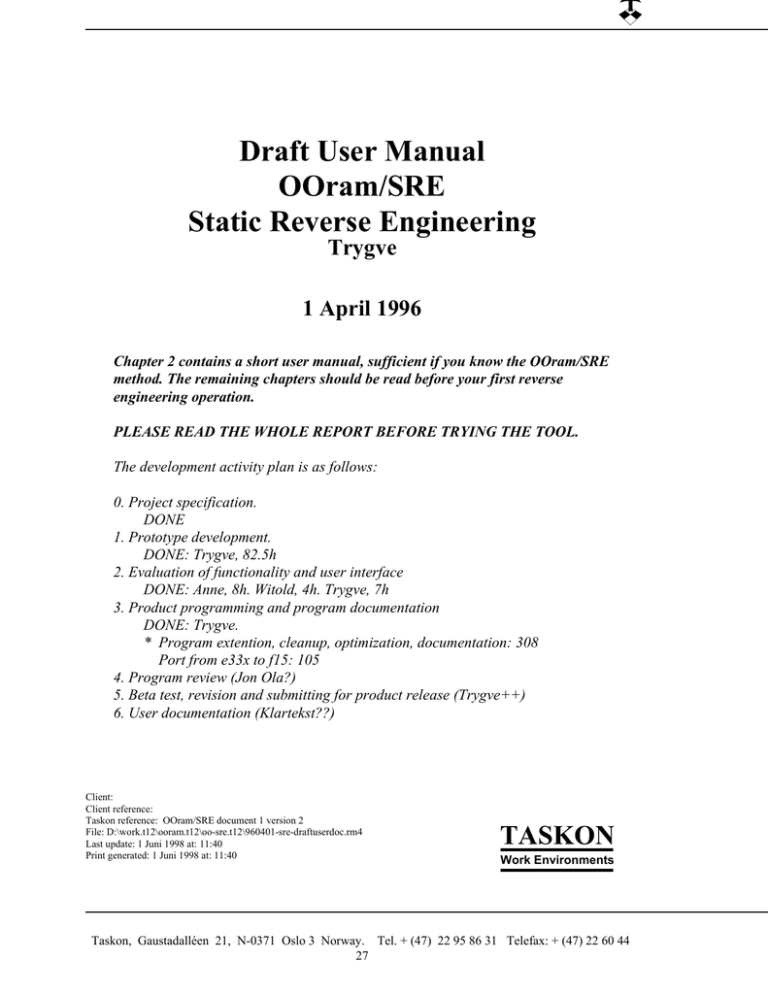
Draft User Manual
OOram/SRE
Static Reverse Engineering
Trygve
1 April 1996
Chapter 2 contains a short user manual, sufficient if you know the OOram/SRE
method. The remaining chapters should be read before your first reverse
engineering operation.
PLEASE READ THE WHOLE REPORT BEFORE TRYING THE TOOL.
The development activity plan is as follows:
0. Project specification.
DONE
1. Prototype development.
DONE: Trygve, 82.5h
2. Evaluation of functionality and user interface
DONE: Anne, 8h. Witold, 4h. Trygve, 7h
3. Product programming and program documentation
DONE: Trygve.
* Program extention, cleanup, optimization, documentation: 308
Port from e33x to f15: 105
4. Program review (Jon Ola?)
5. Beta test, revision and submitting for product release (Trygve++)
6. User documentation (Klartekst??)
Client:
Client reference:
Taskon reference: OOram/SRE document 1 version 2
File: D:\work.t12\ooram.t12\oo-sre.t12\960401-sre-draftuserdoc.rm4
Last update: 1 Juni 1998 at: 11:40
Print generated: 1 Juni 1998 at: 11:40
TASKON
Work Environments
Taskon, Gaustadalléen 21, N-0371 Oslo 3 Norway. Tel. + (47) 22 95 86 31 Telefax: + (47) 22 60 44
27
Background and motivation
Chapter 1
Background and motivation
In the OOram methodology, we distinguish between forward and reverse engineering. In
forward engineering, we start with a problem and describe its solution in a series of
successively more elaborate models such as a System User model, a System Requirements
model, a System Design model, and ,finally, a System Implementation. In reverse
engineering, we start with an implementation and develop one or more System Design
models that highlight important aspects of the implementation.
The OOram SRE (Smallralk Reverse Engineering) product supports the reverse engineering
of Smalltalk programs. It has two main application areas:
1. Recreating the design of old programs. The first application area is in the maintenance of
Smalltalk applications. The program may have been modified during its maintenance
phase, or its design may not have been fully documented during its development phase. In
both cases, it will be useful to document its design before embarking on major revisions.
2. Cleanup after rapid prototyping. The second main application area is as a tool in the
system development phase. Smalltalk is a very expressive language. We frequently find it
easier to determine the functionality and main algorithms through rapid prototyping than
to follow the traditional waterfall process with specification, design, and implementation.
We also find that the rapid prototyping approach yelds a better program from its users'
point of view than the traditional approach.
The first working prototype is not a product, however. It may be satisfactory as oberved
from the outside, but there still remains developing a clean and robust design that covers
rare cases and exceptions as well as the main functionality. The system also needs to be
optimized, and the documentation to be completed. (Early versions of the documentation,
particularly the user documentation, should be developed as part of the rapid prototyping
process).
This document assumes that you are familiar with the OOram methodology, particularly with
the role collaboration diagram with its ports, interfaces, and messages.
Chapter 2 contains a quick guide to the use of OOram/SRE. It should be sufficient if you
already know the OOram/SRE method. The remaining chapters should be read before you try
your first reverse engineering operation.
Draft User Manual OOram/SRE Static Reverse Engineering
©Taskon 1998. Page 1
Overview of the Static Reverse Engineering (SRE) method
Chapter 2
Overview of the Static Reverse Engineering (SRE) method
OOram/SRE (Static Reverse Engineering) is a method for creating a role model collaboration
view of an existing Smalltalk application.
Two Smalltalk images are involved in this method. (They could, as a special case, be the
same image.)
1. The SRE Image is the image containing the role modeling tools with the SRE extensions.
2. The Target Image contains the application classes under study. This image can be any
ObjectWorks\Smalltalk or VisualWorks image extended with an SREAnalyzer filein. It
could even be identical to the SRE Image.
The following files are of interest:
1. The OOram/SRE programs. You find the most current alpha test release in
/vermont/trygve/sre-3:
-
sre3.im2 is the SRE Image. This image is an extension of internal Taskon release f15.
-
sre3.st is the analysis filein for the Target Image. (Note: This filein includes the
WSReadWriter. Use a ChangeList if you file into a Taskon image.)
2. The Target Image. This image is wherever you keep it. (It could be the SRE Image.)
3. The Target Image source code files. You will want to examine Target Image methods, so
it should be set up with source code, and the source files should be accessible from the
SRE Image.
4. A file for data communication between the two Images. Default file name is 'reveng.rev',
but you will be invited to specify some other file name. Analysis specifications are
written by the SRE Image and read by the Target Image. The Target Image augments the
file with the results of the analysis, and the file is finally read by the SRE image to
include the results in the design model(s).
The static reverse engineering method consists of 7 phases:
1. Decide on the area of concern. (Manual.)
Even the simplest Smalltalk program is a fairly complex structure of objects that is linked
directly or indirectly to every other object in the image. You must decide on the domain
of the new role model. Examples are are an application model structure; specific editormodel relationships; the inner details of an editor; and a general mechanism that you want
to study for the purposes of creating a new framework.
Draft User Manual OOram/SRE Static Reverse Engineering
©Taskon 1998. Page 2
Overview of the Static Reverse Engineering (SRE) method
2. Determine role model collaboration structure. (Manual.)
You must identify the objects that are within your domain and represent them in a role
model. The roles and their collaboration structure are determined manually. A good
technique is to interrupt the running application in the Target Image and use the Smalltalk
inspector to explore the objects; choosing suitable roles and their structure.
Record your model in an OOram Collaboration View (in the SRE Image). Give the roles
meaningful names. Create ports for all message communication paths that may be
relevant within the scope of your study. Use the port explanation to record the name and
nature of the variable(s) represented by the port. Make sure to include all ports that may
possibly be relevant; including ports that represent global variables, class variables, and
computed values such as ObjectMemory current. The analysis will not find unspecified
paths and will not look for messages sent from NONE-ports.
3. Specify the names of the classes that implement the roles. (Manual.)
The collaboration view menu command Static reverse engineering opens the SRE tool.
Hit the Specify class names button to open the SRE ClassName tool. You often specify
several classes for one role; they may be independent or in a subclass-superclass
relationship. Each class implements some of the functionality that you want to capture in
the role.
If you do not specify a relevant class, you may miss important messages. If you specify
too many classes, your cleanup job in phase 7 will be unnecessarily tedious.
4. Write an analysis specification file. (Automatic.)
Hit the Write specification button in the SRE Class specifier tool. This writes a binary file
that contains the input data for the interface analysis. The SRE tool asks you for the name
of the communication file, and writes the specification to this file.
5. Perform analysis in Target Image (Automatic).
The SREAnalyzer module (sre2.st) must be filed into the Target Image prior to the
analysis.
The analysis is then done by DoIt the following expression: RMAnModel1
analyzeFromFile. The analyzer reads the specification from the file, performs the
analysis, and overwrites the file with the combined specification and analysis results.
For each specified port, the analyzer determines the messages possibly sent from the
From-Role to the To-Role. The messages are determined as the intersection between two
sets: the set of the selectors of all messages sent from the methods of the From-Role
classes, and the set of the selectors of all methods implemented in the To-Role classes.
The analyzer does not find messages sent indirectly such as with the perform:-command.
(If the Target Image is identical to the SRE Image, you can press the Analyze this image
button in the SRE Class Specifier Tool to trigger the analysis and record the results. The
Class Specifier Tool will then close and the SRE Tool will go directly to phase 7.)
Draft User Manual OOram/SRE Static Reverse Engineering
©Taskon 1998. Page 3
Overview of the Static Reverse Engineering (SRE) method
6. Read the result file into the OOram/SRE image. (Automatic.)
Push the Read analysis button in the SRE tool to read the results of the analysis.
The message interfaces determined by the analysis are recorded in the role model ports
and can be inspected in the SRE tool. New messages are given an interface name
corresponding to the Smalltalk method protocol. The new messages are kept in a
compact form in the SRE part of the system. They are only visible in the SRE Tool, and
are not visible in the regular OOram tools. (To make them visible, see next phase.)
7. Edit interfaces. (Manual.) In this phase, you systematically examine every new message
and determine if it is a regular message that is truly sent through the current port, or if it is
a dummy message.
If the message is a regular message, transform it into a normal OOram message by the
one of the commands: ->Done, ->Default, All->Done, or All->Default.
The automatically generated interfaces contain many dummy messages, i.e., messages
that are implemented in a To-Role class and sent from a From-Role class, but that are not
sent through the current port. A typical example is the message initialize, it is sent and
implemented in most classes, but is typically only sent to self, not to a collaborator.
If the message is a dummy message, move it to the list of dummy messages by one of the
commands: ->Dummy or All->Dummy. Alternatively, you could remove it, but it will
then reappear when you repeat the analysis.
8. Edit roles and collaboration structure:
-
Consider port cardinality. Ports with no messages should be considered changed into NONE
ports. Ports with multiple collaborators should be considerd changed into MANY ports.
-
Consider path removal. Paths with NONE ports at both ends can be removed.
-
Edit explanations. Explanations for roles and messages have been automatically extracted
from class and method comments. They should be used as a starting point for commenting the
roles in the context of the current role model. Edit them to make them describe important
features without being overburdened with details. We typically include description of purpose
and responsibility, but exclude details such as the types of parameters and variables.
-
Consider separation of concern. It may be appropriate to divide a complex model into a
number of simpler ones. You can either make a number of copies the complex model and
simplify them; or create simpler base models with the inverse synthesis operation. Let each
base model cover part of the total scope. The total model can be derived from these base
models, but this is often unnecessary if the separation of concern has been successful.
-
Create an intelligent documentation. A model dump such as the one shown in Appendix 1 is
usually too boring to be really informative. (Try it!) Careful editing and commenting of the
automatically generated report makes it more readable; but it also gives you a maintenance
problem. Consider moving your comments into the model to simplify later maintenance.
Draft User Manual OOram/SRE Static Reverse Engineering
©Taskon 1998. Page 4
Overview of the Static Reverse Engineering (SRE) method
9. If your task is one of re-engineering, you will want to consider improvements in the
extracted model. Some consideration:
-
Consider to distribute the work of roles with a great many collaborators. A true object
oriented system is distributed, not centralized.
-
Ports with very few messages could be considered for indirect access: Send the message to
some other role that will forward it.
-
Look for unnecessary rigidity caused by objects knowing too much about the object structure,
i.e., a method that navigates an object structure and centralizes all the work. Consider
distributing the work to the objects rather than doing the work for them. This simplifies the
object structure and prepares the ground for future extentions through specialization
(subclassing).
-
Look for inherent inefficiencies in computation. Consider if hard-to-get information can be
stored explicitly. It is usually beneficial to maintain direct pointers to important collaborators
rather than executing elaborate navigational algorithms to find them. Hard-to-compute
information can be often cached, but make sure you clear the cache whenever appropriate.
-
Look for inherent inefficiencies in storage. If the same information is stored repeatedly in
many roles, you should consider delegating the storing to a common role. An exception is
when you use caching to improve speed. You must them take great care to maintain
consistency.
Draft User Manual OOram/SRE Static Reverse Engineering
©Taskon 1998. Page 5
Phase 1: Decide on the area of concern (Manual)
Chapter 3
Phase 1: Decide on the area of concern (Manual)
As an example, we will study the Text editing facilities of a Smalltalk program Browser in
our current image (the SRE Image). We want to understand the Text editor specialization of
the Model-View-Controller (MVC), but we do not include the basic MVC framework as
such.
Draft User Manual OOram/SRE Static Reverse Engineering
©Taskon 1998. Page 6
Phase 2: Determine role model collaboration structure. (Manual.)
Chapter 4
Phase 2: Determine role model collaboration structure.
(Manual.)
We interrupted the operation of a Browser, found the TextView object, and inspected its
instance variables. We decided that the phenomenon under study was adequately described
by the role structure of Figure 1??. This was the personal judgment of the analyst, another
analyst could have chosen a different set of roles.
self
ParagraphEdit
or
mod
self
vie
ctr
ctr
dep
Browser
mod
Text
para
txt
Paragraph
para
TextView
self
Figure 1. Text editing in the Browser
NOTE: A crossed-out port denotes a port with no messages associated with it. This is a special notation for the
SRE that we find useful when cleaning up the model after analysis.
Notice that every object you find when inspecting your target object structure is a candidate
to be represented as a separate role, even if these objects are instances of the same class.
You ignore the following kinds of objects:
1. objects that are outside the scope of your study,
2. objects that are adequately represented by an existing role,
3. objects that can be considered enclosed in some other role.
You may want to distinguish between the following kinds of objects:
1. essential object. The object is represented by a separate role in the role model.
2. encapsulated object. The object is considered to be hidden within a role in the context of
the current area of concern
3. set of objects. A set of objects that are indistinguishable in the context of the current area
of concern is represented by a single role that corresponds to one typical member of the
set. An object set is typically accessed through a MANY-port. (The Collection object
itself is then considered encapsulated within the From-Role.)
Draft User Manual OOram/SRE Static Reverse Engineering
©Taskon 1998. Page 7
Phase 2: Determine role model collaboration structure. (Manual.)
4. irrelevant object. An object that is considered totally outside the scope of the current area
of concern. Irrelevant objects may be referenced from environment objects in the current
role model.
A port can represent variables of many different kinds:
1. Global variable. The port will define the interface to a role representing the
corresponding object.
2. Class variable. The port will define the interface to a role representing the corresponding
object.
3. Instance variable. The port will define the interface to a role representing the
corresponding object.
4. Method. The variable is computed by a method.
5. Temporary. The variable is a parameter or a temporary variable in a method. (Always
include an abundance of ports in your initial model in order to capture messages sent
through temporary variables. You can always remove them in the last phase when you are
certain of their irrelevance.)
The OOram reverse engineering method prescribes that ALL relevant paths and messages
shall be shown in the role model. E.g., the expression a b c should be considered expanded
into its constituent parts:
t1 := a b.
t2 := t1 c.
We then consider the variables a, t1, and t2. The corresponding paths are either considered to
be internal to the current role, or they must be shown as separate ports as illustrated in Figure
2??.
A
a
t1
Role
B
t2
C
Figure 2. Role model for the expression a b c.
Draft User Manual OOram/SRE Static Reverse Engineering
©Taskon 1998. Page 8
Phase 2: Determine role model collaboration structure. (Manual.)
The TextView role represents an instance of the TextView class. Inspection of a running
Browser revealed the following instance variables (the explanations have been copied from
the class comments):
1. container <Wrapper | nil> the parent object of the receiver. (aScrollWrapper). Considered
outside the scope of this study.
2. model <Object>. (aBrowser). Represented by port m.
3. controller <Controller>. Represented by port c.
4. scrollOffset <ScrollValueHolder> contains the current scrolling offset and the current
scroll grid. Considered a role attribute, i.e., an object encapsulated within the TextView
role.
5. displayContents <ComposedText> the visual component to use to show the text.
Represented by port dC.
6. startBlock <CharacterBlock> the start selection. Considered a role attribute, i.e., an object
encapsulated within the TextView role.
7. stopBlock <CharacterBlock> the stop selection. Considered a role attribute, i.e., an object
encapsulated within the TextView role.
8. selectionShowing <Boolean> flag indicating whether the selection is ready to be
displayed. Considered a role attribute, i.e., an object encapsulated within the TextView
role.
9. displaySelection <Boolean> flag indicating whether selections will be displayed when
ready. Considered a role attribute, i.e., an object encapsulated within the TextView role.
10. partMsg <Symbol | nil> the text aspect of the model. Inspected value was #textMenu. It is
an important variable. It represents a message selector to be sent by the object through a
perform:, it will NOT be found by the analysis algorithm.
11. acceptMsg <Symbol | nil> the message used to accept text. Inspected value was
#textMenu. It is an important variable. It represents a message selector to be sent by the
object through a perform:, it will NOT be found by the analysis algorithm.
12. menuMsg <Symbol | nil> the message to find a menu in the model. Inspected value was
#textMenu. It is an important variable. It represents a message selector to be sent by the
object through a perform:, it will NOT be found by the analysis algorithm.
13. initialSelectionString <nil | String | Text> nil or a string/text whose first occurrence will
be initially selected.
Figure 3?? shows the OOram Collaboration tool. Note the explanation for the ctr port from
Browser to Controller. The explanation shows that this is a call-back passed as parameter to
the Browser. (The existence and nature of this port could only be determined in phase 7 when
we studied the methods sending messages through the port.)
Draft User Manual OOram/SRE Static Reverse Engineering
©Taskon 1998. Page 9
Phase 2: Determine role model collaboration structure. (Manual.)
Figure 3. Collaboration tool illustrating a port representing a temporary variable.
Draft User Manual OOram/SRE Static Reverse Engineering
©Taskon 1998. Page 10
Phase 3: Specify the names of the classes that implement the roles (Manual)
Chapter 5
Phase 3: Specify the names of the classes that implement
the roles (Manual)
Give the Static Reverse Engineering command in the collaboration diagram to open the SRE
tool shown in Figure 4??.
Figure 4. SRE tool
The obvious class name to associate with a role is the class of the instance it represents as
found in the inspection of phase 2. Also consider if you want to include super- or sub-classes.
If the role can be played by different objects, consider the classes of all these objects in the
same manner. You will often specify the same classes for different roles. This is normal, and
means that instances of these classes (or their subclasses) play different roles.
There are two alternatives for specifying the class names. One is to select a From-Role in the
ReverseEngineering tool while the phase is Specify class names. The class names can then be
edited in the bottom (Text) view. Acceptance is automatic when you leave the text editor.
You will be invited to modify the class name specification if it is syntactically incorrect.
Draft User Manual OOram/SRE Static Reverse Engineering
©Taskon 1998. Page 11
Phase 3: Specify the names of the classes that implement the roles (Manual)
An alternative is to use a special tool. Press the button marked Specify class names in the
SRE tool. This opens the SRE class specifier tool as shown in Figure 5??.
Figure 5. SRE class specifier tool
The class names are written in the fields provided. The specified class names are stored in the
corresponding role whenever a field has been edited.
1. The Undo- and Redo buttons work in the usual manner.
2. The Write specification button will write a file containing the analysis specification, close
the tool, and transfer to the next phase.
3. The Analyze this image button will perform the analysis on the classes in the current
image, close the tool, and transfer to the last, Edit interfaces, phase.
4. If you close the window in any other manner, the specified class names will be
remembered, but the work phase will remain unaltered. Push the Specify class names
button in the SRE tool to reopen this SRE class specifier tool.
Draft User Manual OOram/SRE Static Reverse Engineering
©Taskon 1998. Page 12
Phase 4: Write an analysis specification file (Automatic)
Chapter 6
Phase 4: Write an analysis specification file (Automatic)
The Write specification button in Figure 5?? will close the tool and transfer to the next phase.
Alternatively, you can push the Write specification button in the SRE tool as shown in figure
6??.
Figure 6. Write specification phase in the SRE tool
Figure 7. Specify directory for communication between SRE Image and Target Image
Draft User Manual OOram/SRE Static Reverse Engineering
©Taskon 1998. Page 13
Phase 4: Write an analysis specification file (Automatic)
The tool asks the user for the communication file name as shown in figure 7??, and then
writes the specification to this file. Notice that the file must be written to a directory that is
available in both the SRE and the Target images.
Draft User Manual OOram/SRE Static Reverse Engineering
©Taskon 1998. Page 14
Phase 5: Perform analysis in target image (Automatic)
Chapter 7
Phase 5: Perform analysis in target image (Automatic)
If the Target Image is a different image, you must ensure that the SREAnalyzer module has
been filed in. The filein is in the SRE directory, it is called sre3.st.
The analysis is done by Do it the following expression: RMAnModel1 analyzeFromFile in the
Target Image. The analyzer reads the specification file (reveng.rev), performs the analysis,
and rewrites the same file with the combined specification and result.
If the Target Image is the same as the SRE Image, you can push the text editor command
Analyze this image to perform the analysis and read the result of the analysis in a single
operation. The SRE tool then automatically transfer to the Edit results phase.
Draft User Manual OOram/SRE Static Reverse Engineering
©Taskon 1998. Page 15
Phase 6: Read the result file into the SRE image (Automatic)
Chapter 8
Phase 6: Read the result file into the SRE image
(Automatic)
Push the Read analysis button in the SRE tool to read the results of the analysis.
The message interfaces found in the class analysis are recorded in the role model ports:
1. Messages existing in the role model and found in the analysis are marked as being 'in
class' and otherwise left unchanged.
2. Messages existing in the role model and not found in the analysis are marked as being
'not in class' and otherwise left unchanged.
3. New message selectors are kept in the Port.
4. Old dummy selectors not found in the analysis are removed. (See next chapter.)
The SRE phase is then automatically moved to the last phase: Edit interfaces.
Draft User Manual OOram/SRE Static Reverse Engineering
©Taskon 1998. Page 16
Phase 7: Edit interfaces (Manual)
Chapter 9
Phase 7: Edit interfaces (Manual)
An SRE tool is shown in figure 8?? as it appears in the final phase. It is organized in four
rows:
Menu bar
The menu bar contains menus for the five lists and the text view:
From-Roles
Menu for the first list view
Read reverse engineering results Unnecessary?
Undo
Redo
Remove all empty interfaces in whole role model
Remove all empty paths in whole role model
Move all own messages to default interface in selected Port only
To-Roles
Menu for the second list view
Read reverse engineering results Unnecessary?
Undo
Redo
Interfaces
Menu for the Interface list
Add interface
Remove interface
All -> Default change state all messages in selected interface
All -> Done change state all messages in selected interface
All -> Dummy change state all messages in selected interface
Find message select from all messages in all interfaces
Undo
Redo
Messages
Menu for the message list
->Default change state selected message
->Done transform selected message into regular message
->Dummy change state selected message
Reset Status change state selected message
Undo
Redo
Remove message
Methods
Menu for the Methods list
toggle to senders toggle contents of method list
toggle to receivers toggle contents of method list
Contents
Menu for the bottom, text view. The view is read-only, so there is only
one active command:
Copy
Draft User Manual OOram/SRE Static Reverse Engineering
©Taskon 1998. Page 17
Phase 7: Edit interfaces (Manual)
Filter row Four toggle buttons for filtering interfaces and messages on certain properties:
List row
Text view
Show In Model
Messages defined in the role model in the normal way are shown if
the button is ON, suppressed if it is OFF.
Show In Class
Messages found during Target Image analysis are shown if the button
is ON, suppressed if it is OFF.
Show Dummy
Messages moved to dummy are shown if the button is ON, suppressed
if it is OFF.
Include Base
Base model messages are included if the button is ON, suppressed if
it is OFF.
A browser-like sequence of lists for navigating in the model:
From-Roles
List of all roles in the role model. Select one to study the messages it
sends to its collaborators. (Showing roles with non-empty interfaces
after filtering only.)
To-Roles
List of all the selected From-Role's collaborator roles. Select one to
study the interfaces. This is equivalent to selecting a port in the
collaboration view. (Showing ports with non-empty interfaces after
filtering only.)
Interfaces
List of interfaces for messages specified from From-Role to To-Role.
Automatically generated interfaces are named as one of the
corresponding Smalltalk protocol names. The list is filtered by the
current setting of the filter buttons. (Showing non-empty interfaces
after filtering only.)
Messages
List of messages in the selected interface. The list is filtered by the
current setting of the filter buttons.
Method list
The user can toggle between two lists in the rightmost list view:
Sending Methods
The methods in the From-Role classes that send
the selected message.
Receiving Methods
The methods in the To-Role classes that
implement the selected message.
This view is a text view that either shows the class names associated with the selected
From-Role, or the method selected in the rightmost list view. The selected message is
highlighted as bold text in the method code.
The presented method was extracted during analysis in the Target Image and the
displayed source is read from the Target Image source files. The Text view is therefore
read-only, the usual Browsing commands such as senders, implementors, and messages
are not available.
Draft User Manual OOram/SRE Static Reverse Engineering
©Taskon 1998. Page 18
Phase 7: Edit interfaces (Manual)
Menu Bar
Filter row
List row
Phase buttons
Text view
Figure 8. Browsing message senders, finding a dummy
Figure 8?? shows a typical example of a dummy message: The doitReceiver message is sent
from a Browser method and is implemented by a Controller class. Inspecting the method, we
find that the message is actually sent to self. We therefore give the ->Dummy Interface
command in the Messages list menu to move the message out of the way. (The filter setting is
typical for the cleanup operation: Show In Model, Show Dummy, and Include Base are OFF,
Show In Class is ON. The lists then only show messages that have not yet been considered.)
Notice that a message is a dummy message only if there is no method that sends it to the ToRole.
Draft User Manual OOram/SRE Static Reverse Engineering
©Taskon 1998. Page 19
Phase 7: Edit interfaces (Manual)
Figure 9. Browsing message senders, finding a proper message
The example shown in figure 9?? is a typical, proper message. We see that
ParagraphEditor>>paragraph sends the message displayContents to the view instance
variable, that is the variable represented by the TextView<Controller port. By convention, we
use the Message list command ->Default interface to change its interface to the default
interface.
Notice that a message is a proper message if at least one of the methods send it to the ToRole.
Draft User Manual OOram/SRE Static Reverse Engineering
©Taskon 1998. Page 20
Phase 7: Edit interfaces (Manual)
Figure 10. Browsing message senders, finding a call-back message
In the the usual MVC framework, the Model does not know the Controller. In the example of
figure 10??, however, the Browser (Model) gets reference to the Controller in a message
parameter and uses this knowledge to return messages to the Controller. There must therefore
be a port from the Browser to the Controller, even if its life span is limited to a single method
invocation.
Draft User Manual OOram/SRE Static Reverse Engineering
©Taskon 1998. Page 21
Phase 7: Edit interfaces (Manual)
Figure 11. Browsing message senders, an obscure case
Figure 11?? represents a somewhat obscure case. The method
ParagraphEditor>>doItReceiver sends the message doItReceiver to self evaluator; but is this
one of our roles or is it to be suppressed in our role model? We have to revert to the Target
Image and investigate in depth.
An easy way out is to interrupt the execution of a Browser and open an inspector on the
Controller. We find that self evaluator evaluates to a Browser1, the doItReceiver message is
therefore sent to the Browser and is a proper message in this port.
As a check, we browse the relevant methods and find that the collaboration structure is not
always evident from the code:
ParagraphEditor>>evaluator (private)
evaluator
"Answer the object that defines the context of an evaluation"
^self performer == self
ifTrue: [self model]
ifFalse: [self performer]
ControllerWithMenu>>performer (accessing)
performer
"Answer the receiver of menu messages."
^performer
Draft User Manual OOram/SRE Static Reverse Engineering
©Taskon 1998. Page 22
Phase 7: Edit interfaces (Manual)
Who sets this value and when? We find that it is set to self in the initialize method and that it
is modified by the performer: method. An interesting sender is
TextController>>model: (model access)
model: aModel
super model: aModel.
self performer: aModel
So the evaluator is the performer, the performer is the model, the model is the Browser role.
So the doItReceiver message is sent to the Browser.
Draft User Manual OOram/SRE Static Reverse Engineering
©Taskon 1998. Page 23
Phase 8: Edit roles and collaboration structure
Chapter 10
Phase 8: Edit roles and collaboration structure
The goal of this phase is to manipulate the model in order to make it easier to understand.
The following hints may be useful.
1. Consider port cardinality. Ports with no messages should be considered changed into
NONE ports. Ports with multiple collaborators should be considerd changed into MANY
ports.
2. Consider path removal. Paths with NONE ports at both ends can be removed.
3. Edit explanations. Explanations for roles and messages have been extracted from class
and method comments. They should be used as a starting point for commenting the roles
in the context of the current role model. Edit them to make them describe important
features without being overburdened with details. We typically include description of
purpose and responsibility, but exclude details such as the types of parameters and
variables.
4. Consider separation of concern. It may be appropriate to divide a complex model into a
number of simpler ones. You can either make a number of copies the complex model and
simplify them; or create simpler base models with the inverse synthesis operation. Let
each base model cover part of the total scope. The total model can be derived from these
base models, but this is often unnecessary if the separation of concern has been
successful.
In our text editor example, we could have separated out the TextView-Paragraph-Text
part in a separate base model. We could also have created a general MVC base model,
and made the Browser-TextView-ParagraphEditor into a derived model.
5. Create an intelligent documentation. A model dump such as the one shown in Appendix
1 is usually too boring to be really informative. (Try it!) Careful editing and commenting
of the automatically generated report makes it more readable; but it also gives you a
maintenance problem. Consider moving your comments into the model to simplify later
maintenance.
If your task is one of re-engineering, you will want to consider improvements in the extracted
model. Some consideration:
1. Consider to distribute the work of roles with a great many collaborators. A true object
oriented system is distributed, not centralized.
2. Ports with very few messages could be considered for indirect access: Send the message
to some other role that will forward it.
Draft User Manual OOram/SRE Static Reverse Engineering
©Taskon 1998. Page 24
Phase 8: Edit roles and collaboration structure
3. Look for unnecessary rigidity caused by objects knowing too much about the object
structure, i.e., a method that navigates an object structure and centralizes all the work.
Consider distributing the work to the objects rather than doing the work for them. This
simplifies the object structure and prepares the ground for future extentions through
specialization (subclassing).
4. Look for inherent inefficiencies in computation. Consider if hard-to-get information can
be stored explicitly. It is usually beneficial to maintain direct pointers to important
collaborators rather than executing elaborate navigational algorithms to find them. Hardto-compute information can be often cached, but make sure you clear the cache whenever
appropriate.
5. Look for inherent inefficiencies in storage. If the same information is stored repeatedly in
many roles, you should consider delegating the storing to a common role. An exception is
when you use caching to improve speed. You must them take great care to maintain
consistency.
Draft User Manual OOram/SRE Static Reverse Engineering
©Taskon 1998. Page 25
Discussion
Chapter 11
Discussion
A detailed report of the sample role model is given in Appendix 1.
We see that there is no interface from Browser to TextView, this is as expected since we did
not include the MVC classes in the analysis (View and Object + Model)
The analysis did not find an interface from TextView to Browser. This is bad, since there are
clearly relevant messages in this interface. The TextView is a pluggable, and these essential
message selectors are store in instance variables and sent by perform:. Returning to the
TextView object inspected in the Target Image, we found that the interesting messages were
#text, #acceptText:from:, and #textMenu. We could have found these messages by studying
the class comment, see Chapter 4.
We see that there is a rich interface from TextView to Paragraph. Closer study may offer
opportunities for simplification. We also see that there is an even richer interface from
ParagraphEditor to TextView. These complex interfaces are strong indicators that the
distribution of attributes and functionality between the ParagraphEditor, TextView and
Paragraph objects should be reconsidered.
Draft User Manual OOram/SRE Static Reverse Engineering
©Taskon 1998. Page 26
Sample Role Model
Appendix 1
Sample Role Model
App 1.1
Area of Concern
As an example, we will study the Text editing facilities of a Smalltalk program Browser in our current
image (the SRE Image). We want to understand the Text editor specialization of the Model-ViewController (MVC), but we do not include the basic MVC framework as such.
Stimulus messages
1.
ParagraphEditor
-
accept {Message}
-
again {Message}
Text substitution. If a shift key is down, the substitution is made
throughout the entire Paragraph. Otherwise, only the next possible
substitution is made.
-
againConfirm {Message}
Text substitution. If the left shift key is down, the substitution is made
throughout the entire Paragraph. Otherwise, only the next possible
substitution is made. Prompt to confirm substitution.
5 May 1989 trygve: <<<60>>>
29 December 1990 trygve st4.0
3 April 1992 trygve st4.1.
950407 als (vw): leftShiftDown -> shiftDown
-
cancel {Message}
-
copySelection {Message}
Copy the current selection and store it in the shared buffer.
-
cut {Message}
-
find {Message}
Open the find dialog. If the user picks Cancel, then do nothing.
Otherwise, search for the next occurrence of the text from the dialog.
-
paste {Message}
Paste the text from the shared buffer over the current selection and redisplay
if necessary. If the shift key is down, present the user with a menu of
the last few selections.
-
replace {Message}
Open the find/replace dialog. If the user picks Cancel, then do nothing.
If the user picks Find (default), then so a search.
If the user picks FindAndReplace, then do a search and if found replace.
-
undo {Message}
Reset the state of the paragraph prior to the previous cut or paste edit.
Draft User Manual OOram/SRE Static Reverse Engineering
©Taskon 1998. Page 27
Sample Role Model
App 1.2
The Roles
self
ParagraphEdit
or
mod
self
ctr
vie
Browser
ctr
dep
mod
Text
para
txt
Paragraph
para
TextView
self
1.
Text Class Text handles protocol for treating strings of characters as displayable characters that can have
emphasis and font changes. The emphasis codes indicate abstract changes in character appearance. Actual
display is performed in the presence of a TextAttributes which indicates, for each abstract code, an actual
font to be used.
2.
Paragraph TextLines is the abstract superclass for classes that display lines of stylized text.
Class ComposedText provides the support for creating, modifying and displaying stylized text.
3.
TextView A ComposedTextView represents a Text. The Text should not be changed by any editing unless
the user issues the accept command. Thus an instances provides a working copy of the Text. This copy is
edited. When the user issues the accept command, the Text is copied from the working version; or if the
user issues the cancel command, the working version is restored from the Text.
TextView is a "pluggable" view of text. The notion of pluggable views is to provide a view that can be
plugged onto any object, rather than having to define a new subclass specific to every kind of object that
needs to be viewed. The chief mechanism is a set of selectors, which can be thought of as an adaptor to
convert the generic TextView operations into model-specific operations (such as textMenu). See the
protocol 'adaptor' for use of the pluggable selectors. See the creation messages in the class for an
explication of the various parameters. Browse senders of the creation messages in the class for examples in
the system. It also includes support for setting the initial selection to a part of the text.
4.
ParagraphEditor Class ParagraphEditor contains the main handling of text editing. It ought to be used
only on smallish texts.
As a subclass of the ParagraphEditor, class TextController uses Menus for model control protocol. It also
makes a stab (localMenuItem:) at the problem of distinguishing user control directed at the model from that
directed at the view/controller. This controller is more tightly connected to its view (for example it asks it
for its yellowButtonMenu), because the view is the current site for "pluggable" parameterization.
5.
Browser A browser represents a hierarchical query path through an organization of class and method
information. A full path query identifies a Smalltalk method to be examined.
Draft User Manual OOram/SRE Static Reverse Engineering
©Taskon 1998. Page 28
Sample Role Model
App 1.3
Interaction Scenarios
App 1.3.1
Scenario Accept Method
ParagraphEditor
TextView
Browser
Text
Paragraph
accept
doAccept
acceptMessage
(#acceptText:from:)
acceptText:from:
acceptMethod:from:
newSelectorList:
changed:
(#selector)
update:with:from:
update:with:
update:
getContents
text
newText:
editText:
setCompositionWidth:
setText:
resetState
Figure 12. Accept Method {Scenario}
There are different accept activities for the different kinds of text handled by the Browser. This
scenario shows a typical example of accepting a method. The new source code is given to the
Browser where it is compiled. update-messages are sent to the dependents, the Browser's TextView.
The TextView tells its Controller that textHasChanged:. A somewhat indirect way of telling the activity
originator something it really knew all the time.
Draft User Manual OOram/SRE Static Reverse Engineering
©Taskon 1998. Page 29
Sample Role Model
ParagraphEditor>>accept (menu messages)
accept
"Save the current text of the text being edited as the current acceptable
version for purposes of canceling."
self textHasChanged: false.
model value: self text copy
TextController>>accept (menu messages)
accept
(self textHasChanged and: [model changeRequestFrom: view])
ifFalse: [^view flash].
self doAccept
ifTrue: [self textHasChanged: false]
ifFalse: [view flash]
TextController>>doAccept (private)
doAccept
"Send the accept message to the model. Answer what the model answers."
| acceptMsg |
acceptMsg := view acceptMessage.
acceptMsg == nil ifTrue: [view flash. ^ false].
^ acceptMsg numArgs = 1
ifTrue: "one arg selectors get text only"
[model perform: acceptMsg with: self text]
ifFalse: "two arg selectors get text and controller as well"
[model perform: acceptMsg with: self text with: self]
TextView>>acceptMessage (adaptor)
acceptMessage
"Answer the message sent to the model on accept."
^acceptMsg
Browser>>acceptText:from: (doIt/accept/explain)
acceptText: aText from: aController
"Text has been changed. Store or compile the text, depending on
the current mode of the receiver."
textMode == #classDefinition ifTrue:
[^ self acceptClass: aText from: aController].
textMode == #methodDefinition ifTrue:
[^ self acceptMethod: aText from: aController].
textMode == #categories ifTrue:
[Cursor wait showWhile:
[organization changeFromString: aText string.
self newCategoryList: category].
^true].
textMode == #protocols ifTrue:
[self selectedClass organization changeFromString: aText string.
self selectedClass reorganize.
self selectedClass logOrganizationChange.
self textMode: #protocol; newProtocolList: nil.
^ true].
textMode == #comment ifTrue:
[self nonMetaClass comment: aText string.
self textMode: #comment; newProtocolList: nil.
^ true].
^ false
Draft User Manual OOram/SRE Static Reverse Engineering
©Taskon 1998. Page 30
Sample Role Model
Browser>>acceptMethod:from: (private-selector functions)
acceptMethod: aText from: aController
| newSelector |
newSelector := self selectedClass
compile: aText
classified: protocol
notifying: aController.
newSelector == nil ifTrue: [^false].
newSelector == selector
ifFalse: [self newSelectorList: newSelector].
^true
Browser>>newSelectorList: (selector list)
newSelectorList: initialSelection
"Set the currently selected message selector to be initialSelection."
selector := initialSelection.
self changed: #selector
ComposedTextView>>update: (updating)
update: aSymbol
"The receiver's model has changed its text. Update the receiver."
self updateDisplayContents
TextView>>update: (updating)
update: aSymbol
"If aSymbol = partMsg then read the text to edit from the receiver's model
and update the display."
| text |
aSymbol == partMsg
ifTrue:
[text := self getContents.
displayContents text ~= text
ifTrue:
[self newText: text.
self initializeSelection.
"Translate so the selection is visible"
self positionToSelection.
selectionShowing := true.
self invalidate]
ifFalse:
[self resetController]]
ComposedTextView>>getContents (model access)
getContents
"Answer the text that the receiver is viewing."
^model value
TextView>>getContents (model access)
getContents
| text |
partMsg == nil ifTrue: [^Text new].
text := model perform: partMsg.
text == nil ifTrue: [^Text new].
^ text
Draft User Manual OOram/SRE Static Reverse Engineering
©Taskon 1998. Page 31
Sample Role Model
Browser>>text (text)
text
| text |
textMode == #classDefinition ifTrue:
[className == nil
ifTrue: [^ (Class template: category) asText]
ifFalse: [^ self selectedClass definition asText]].
textMode == #methodDefinition ifTrue:
[selector == nil
ifTrue: [^ self selectedClass sourceCodeTemplate asText]
ifFalse: [^ (self selectedClass sourceCodeAt: selector) asText
makeSelectorBoldIn: self selectedClass]].
textMode == #category ifTrue:
[^ 'category to add' asText].
textMode == #categories ifTrue:
[^ organization printString asText].
textMode == #protocol ifTrue:
[^ 'protocol to add' asText].
textMode == #protocols ifTrue:
[^ self selectedClass organization printString asText].
textMode == #comment ifTrue:
[text := self selectedClass comment asText.
text isEmpty ifFalse: [^ text].
self selectedClass isMeta ifTrue: [^'Select the browser switch "instance" to see the comment'
asText].
^ self selectedClass commentTemplateString asText].
textMode == #hierarchy ifTrue:
[^ self selectedClass printHierarchy asText].
^ Text new
ComposedTextView>>newText: (model access)
newText: aText
"Set aText to be the text model for the receiver."
aText == nil ifTrue: [^ self newText: Text new].
self editText: aText
ComposedTextView>>editText: (model access)
editText: aText
"The paragraph to be displayed is created from the characters in aString."
self isOpen
ifTrue: [displayContents setCompositionWidth: self wrappingBox width.
displayContents text: aText asText copy]
ifFalse: [displayContents setCompositionWidth: ComposedText defaultCompositionWidth.
displayContents setText: aText asText copy].
self setToTop.
startBlock := stopBlock := nil.
selectionShowing := true.
self controller. "Make sure we have a controller"
self resetController.
self changedPreferredBounds: nil
ComposedText>>setCompositionWidth: (display box accessing)
setCompositionWidth: aSmallInteger
"Set the width for composition to be aSmallInteger."
"Make sure the composition width in not negative.
The CompositionScanner requires this."
compositionWidth := aSmallInteger max: 0
Draft User Manual OOram/SRE Static Reverse Engineering
©Taskon 1998. Page 32
Sample Role Model
ComposedText>>setText: (accessing)
setText: aText
"Set the text without recomposing. Invalidate the compositionHeight
and lineTable so that recomposition happens later"
text := aText.
lineTable := compositionHeight := nil.
ParagraphEditor>>resetState (initialize-release)
resetState
"Establish the initial conditions for editing the paragraph: set the emphasis to that of the first
character."
self resetTypein.
emphasisHere := self text emphasisAt: 1.
self textHasChanged: false
App 1.4
Implementation classes
NOTE:
We have deleted most of the code report, it is not interesting in the context of the SRE User
manual.
App 1.4.1
Browser implementation
Model subclass: #Browser
instanceVariableNames: 'organization category className meta protocol selector textMode
'
classVariableNames: 'CategoryMenu ClassMenu LastProtocol MessageMenu
MethodMoveProtocol ProtocolMenu RemoveChangesOnFileOut TextMenu '
poolDictionaries: ''
category: 'TM-Browser+'
A browser represents a hierarchical query path through an organization of class and method
information. A full path query identifies a Smalltalk method to be examined.
Instance Variables:
organization <SystemOrganizer>
category <String> a selection from all categories in the organization.
className <Symbol> a selection from all classes in the category.
meta
<Boolean> false for viewing instance methods, true for class methods.
protocol <Symbol> a selection from all protocols in the class.
selector <Symbol> a selection from all messages in the protocol.
textMode <Symbol> indicating the nature of the currently viewed text
Class Variables:
CategoryMenu <Menu | nil> of operations on the class categories
ClassMenu
<Menu | nil> of operations and queries about a class
LastProtocol <Symbol | nil> last message category selected
Draft User Manual OOram/SRE Static Reverse Engineering
©Taskon 1998. Page 33
Sample Role Model
MessageMenu <Menu | nil> of operations on the message categories
MethodMoveProtocol <CharacterArray | nil> last message category used in a move
ProtocolMenu <Menu | nil> of operations and queries about a message
RemoveChangesOnFileOut <Boolean> flags whether to remove classes from the ChangeSet
when they are filed out
TextMenu
<Menu | nil> of text editing operations
See above for method Browser>>#acceptMethod:from:
See above for method Browser>>#acceptText:from:
Browser>>doItReceiver (doIt/accept/explain)
doItReceiver
"Answer the object that should be informed of the result of evaluating a
text selection."
^ self nonMetaClass
See above for method Browser>>#newSelectorList:
See above for method Browser>>#text
App 1.4.2
ComposedText implementation
TextLines subclass: #ComposedText
instanceVariableNames: 'text compositionWidth compositionHeight wordWrap fontPolicy
lineTable fitWidth '
classVariableNames: 'DefaultCompositionWidth '
poolDictionaries: 'TextConstants '
category: 'Graphics-Text Support'
Class ComposedText provides the support for creating, modifying and displaying stylized text.
Instance Variables:
compositionWidth <SmallInteger> The width of the area in which the text is composed.
The composition width includes any space taken up
by indentation.
compositionHeight <SmallInteger> The height of the composition
fitWidth
<Boolean>
True if the composed text was created shrink to fit.
fontPolicy
<FontPolicy> The place where fonts are obtained
lineTable
<LineInformationTable>
text
<Text>
wordWrap
<Boolean>
The flag to indicate whether word wrapping is turned on
Class Variables:
DefaultCompositionWidth <SmallInteger> used for composition unless otherwise specified
ComposedText>>characterBlockAtPoint: (character location)
characterBlockAtPoint: aPoint
"Answer a CharacterBlock for characters in the text at point aPoint."
^self getCharacterBlockScanner characterBlockAtPoint: aPoint in: self
Draft User Manual OOram/SRE Static Reverse Engineering
©Taskon 1998. Page 34
Sample Role Model
ComposedText>>characterBlockForIndex: (character location)
characterBlockForIndex: targetIndex
"Answer a CharacterBlock for character in the text at targetIndex. The
coordinates in the CharacterBlock are in the coordinates of the receiver."
^self getCharacterBlockScanner characterBlockForIndex: targetIndex in: self
ComposedText>>composeAll (accessing)
composeAll
"Compose a collection of characters into a collection of lines."
| startIndex stopIndex lineIndex maximumRightX compositionScanner |
lineTable :=self newLineTable.
maximumRightX := 0.
text size = 0
ifTrue:
[self setHeight: 0.
lineTable lastStop: 0.
^maximumRightX].
startIndex := lineIndex := 1.
stopIndex := text size.
compositionScanner := self getCompositionScanner.
[startIndex > stopIndex] whileFalse:
[| lineRight |
self nextLineItem: startIndex line: lineIndex with: compositionScanner.
lineTable
lineAt: lineIndex
putInformationFromScanner: compositionScanner.
lineRight := compositionScanner rightX.
maximumRightX < lineRight ifTrue: [maximumRightX := lineRight].
startIndex := compositionScanner lineLast + 1.
lineIndex := lineIndex + 1].
self updateCompositionHeight.
lineTable lastStop: text size.
lineTable trimLinesTo: lineIndex - 1.
^maximumRightX
Draft User Manual OOram/SRE Static Reverse Engineering
©Taskon 1998. Page 35
Feedback from functionality and user interface evaluation
Appendix 2
Feedback from functionality and user interface evaluation
1.
Image-image communication not needed if SRE and Target images the same.
Done. Special command for analysis in same image.
2.
BOSS dangerous for image-image communication.
Changed to WSReadWriter. Incidentally, a specification/result file size reduced by factor 10!
3.
User selectable name of communication file.
Done. Same file now used for communication in both directions.
4.
Feedback during analysis needed.
Done.
5.
Should highlight interfaces and messages not found in analysis.
Done. Collaboration tool now highlights such messages and interfaces by italics font. Also, empty ports
(=ports without messages) shown crossed out. Filters in Reverse Engineering tool filters on 'done', 'in
class', 'dummy', and 'base'.
6.
It would be useful with some statistics and metrics such as:
NOT DONE
-
List interfaces sorted on no. of messages
-
Show messages (selector) sent from several ports and/or interfaces
-
No. of methods/role
-
Messages used once only
-
Ports/role
-
Sending of messages classified as private
-
List of method overrides
7.
Better handling of dummy messages and interfaces
Done. Dummy messages and interfaces now stored compactly in RMREPort, not shown in regular OOram
tool.
8.
Generate self messages.
Done by defining two collaborating roles with identical associated class names.
9.
Browse methods from SRE tool if same image.
Not done, use regular Browser.
10. Show number of selector occurrences in method source code.
Done
11. Many redundant refreshes.
Fixed. It was not easy, but is now hopefully OK.
12. Check if source files exist and are available.
Done. If trouble, user is invited to specify Target source file names.
13. Remove empty interfaces.
Done. Chose to provide command in SRE tool rather than making it automatic.
Draft User Manual OOram/SRE Static Reverse Engineering
©Taskon 1998. Page 36
TABLE OF CONTENTS
Chapter 1
Background and motivation
1
Chapter 2
Overview of the Static Reverse Engineering (SRE)
method
2
Chapter 3
Phase 1: Decide on the area of concern (Manual)
6
Chapter 4
Phase 2: Determine role model collaboration structure.
(Manual.)
7
Chapter 5
Phase 3: Specify the names of the classes that
implement the roles (Manual)
11
Chapter 6
Phase 4: Write an analysis specification file
(Automatic)
13
Chapter 7
Phase 5: Perform analysis in target image (Automatic)
15
Chapter 8
Phase 6: Read the result file into the SRE image
(Automatic)
16
Chapter 9
Phase 7: Edit interfaces (Manual)
17
Chapter 10
Phase 8: Edit roles and collaboration structure
24
Chapter 11
Discussion
26
Appendix 1
Sample Role Model
27
App 1.1
Area of Concern
27
App 1.2
The Roles
28
App 1.3
App 1.3.1
Interaction Scenarios
Scenario Accept Method
29
29
Draft User Manual OOram/SRE Static Reverse Engineering
<i>
App 1.4
App 1.4.1
App 1.4.2
Appendix 2
Implementation classes
Browser implementation
ComposedText implementation
33
33
34
Feedback from functionality and user interface
evaluation
36
Draft User Manual OOram/SRE Static Reverse Engineering <ii>
INDEX
Browser>>acceptMethod:from: (private-selector functions)
31
Browser>>acceptText:from: (doIt/accept/explain)
30
Browser>>doItReceiver (doIt/accept/explain)
34
Browser>>newSelectorList: (selector list)
31
Browser>>text (text)
32
ComposedText>>characterBlockAtPoint: (character location)
34
ComposedText>>characterBlockForIndex: (character location)
35
ComposedText>>composeAll (accessing)
35
ComposedText>>setCompositionWidth: (display box accessing)
32
ComposedText>>setText: (accessing)
33
ComposedTextView>>editText: (model access)
32
ComposedTextView>>getContents (model access)
31
ComposedTextView>>newText: (model access)
32
ComposedTextView>>update: (updating)
31
ControllerWithMenu>>performer (accessing)
22
ParagraphEditor>>accept (menu messages)
30
ParagraphEditor>>evaluator (private)
22
ParagraphEditor>>resetState (initialize-release)
33
TextController>>accept (menu messages)
30
TextController>>doAccept (private)
30
TextController>>model: (model access)
23
TextView>>acceptMessage (adaptor)
30
TextView>>getContents (model access)
31
TextView>>update: (updating)
31
Draft User Manual OOram/SRE Static Reverse Engineering
<i>
